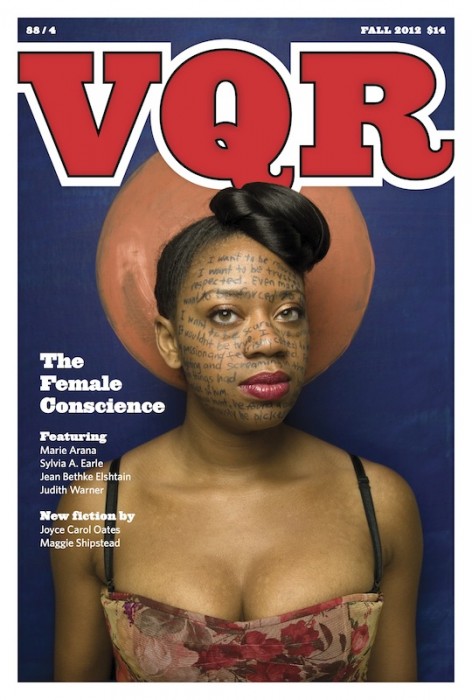
Counting Women
In recent years, the organization VIDA—Women in the Literary Arts has tallied the number of female and male contributors to leading cultural magazines. It’s called The Count. The findings are shocking: 20-30 percent of contributors to publications such as Harper’s, the Atlantic, and the New Yorker are female. For VQR, this year’s count is 49.
Forty-nine percent of our contributors in 2012 are women.
However, this figure doesn’t tell the entire story.
VQR is buoyed in regards to gender equality because of the remarkable Fall 2012 issue led by guest editor Marie Arana. Well known as a novelist, memoirist, and book critic, Marie is Writer at Large for the Washington Post and Senior Consultant to the Librarian of Congress. Marie decided to center the fall issue of VQR on “The Female Conscience”—a term broad enough to encompass many ideas and arguments, even contradictory ones.
In a span of mere weeks, she had gathered commitments to contribute from internationally recognized field leaders, varying from oceanographer Sylvia A. Earle to cultural critic Judith Warner to writer Joyce Carol Oates. We added our own selections of previous VQR contributors, such as Maggie Shipstead and Nadia Shira Cohen. We soon found ourselves with an embarrassment of riches. Ultimately, the VQR staff and Marie decided that—with a few exceptions—the entire issue would be by or about women.
Of course, and importantly, we are not publishing these individuals because of gender, but rather because of their artistic excellence.
The Count is useful. But it has its limits. And its blind spots.
For example, William Logan wrote 17,000 words—more than fifty manuscript pages—on Elizabeth Bishop for our spring 2012 issue. In terms of The Count, this groundbreaking biographical essay is a negative on the gender ledger because a man wrote it. To be sure, VIDA does have other Counts for topics such as authors reviewed, and in that case the Bishop essay would go in the female column, but that doesn’t change the primary, headline Count.
In another case, VQR spent some $5,000 in travel expenses and compensation to send a female correspondent to a foreign country to write a 10,000-word feature. In the same issue, we published a short poem by a male who we paid $200. We also paid for a female photographer to create a film and photo essay in Eastern Europe; and we purchased a single photograph from a male who we decided to list on the contributors’ page. They are all “counted” the same.
Still, The Count matters.
Without the Fall 2012 issue, the VQR Count would have been above the industry average, but disappointing. Indeed, does VQR seem unduly inclusive by averaging into the annual mix an issue with more than 85 percent female contributors? Probably.
We should do better, issue by issue.
Setting ASIDE the count, our readers can judge how we value the contributions of women based upon other factors, especially with the late 2011 and 2012 issues, as they indicate the philosophical positions of the new VQR staff.
Our past five front covers have featured women and/or girls, with their narratives within. In 2011, under former editor Ted Genoways, the magazine made all five annual $1,000 awards for fiction, poetry, essay, and photography to women for works published in our pages that year.
The 2011 VQR award list includes a National Magazine Award finalist story by Maggie Shipstead (“La Moretta”), a wonderful new novelist who made the New York Times best seller list this fall. We published her long before her first book came out. We are pleased that she has a new story, “Labor,” in our Fall 2012 issue.
The 2011 VQR award list also includes photographer Maisie Crow, still in her twenties, who received an Overseas Press Club award for her film on our website. (The New York Times came in second.) Crow edited the film in our offices. Since her work on that piece, CNN and the New York Times have sought her out and published her photographs.
For the Spring 2012 all-poetry issue, we had about 40 percent female contributors, including U.S. Poet Laureate Natasha Trethewey. Last month we issued a limited-edition broadside of her poem that ran in the issue. Previously, she published a large portion of her Pulitzer-winning collection with us before the book came out. We are proud that she is a VQR Contributing Editor who recommends new voices to us.
For our summer 2012 lead story, we published Delphine Schrank on Burmese dissidents and how they challenged the reign of a repressive military junta. She was joined in the issue by contributors Edith Pearlman, Janna Malamud Smith, and others. We also value female artists as subjects: in Spring 2012, features on Elizabeth Bishop and H.D.; in Summer 2012, on Kay Ryan; this fall, on Anne Morrow Lindbergh.
We aren’t just accepting work from women after they are famous; we are committing to emerging female writers, photographers, and poets. Over the decades, we published the young Katherine Anne Porter, Adrienne Rich, Nadine Gordimer, Joyce Carol Oates, and Natasha Trethewey. We have benefited greatly from their loyalty thereafter.
Such contributions cannot be reduced to raw numbers.
Yet, raw numbers matter.
The Count does hold us accountable for our decisions. It reminds us to be truly open to all as we identify, nurture, and promote the talented creators of today and tomorrow.


